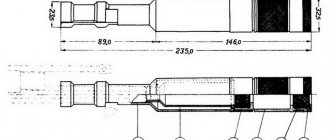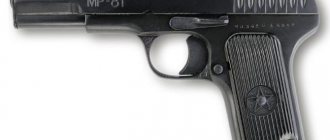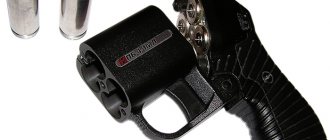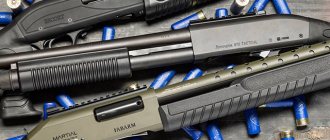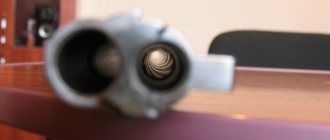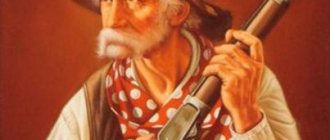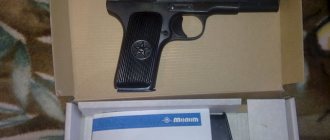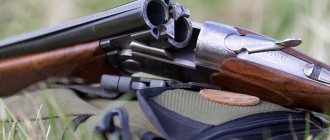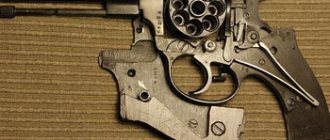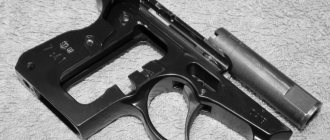Pneumatic weapons (translated from ancient Greek “pneuma” - wind, breath) are a type of small arms in which a bullet flies out under the influence of compressed gas (can be liquefied, hardened).
Such weapons arose many centuries ago and were mainly used for hunting and self-defense. And in the 17th and early 19th centuries, it even successfully competed with firearms and gunpowder, having many advantages: greater rate of fire and accuracy, resistance to changing weather conditions, almost noiselessness, and the absence of smoke, which indicates the location of the shooter and unmasks it.
Nowadays it is often used for entertainment (shooting from short distances) or as sports equipment. But even now, many people choose pneumatic smoothbore pistols for self-defense, and this has its own logic. Any air pistol is a full-fledged weapon.
Types of Air Guns
There are many companies on the modern market that produce air guns. There are both domestic and foreign enterprises.
Domestic products often surpass imported ones in power and reliability. Air pistols appeared not so long ago. Usually they completely imitate military analogs that are most famous and popular in the arms industry (Beretta, Colt, Smith and Wesson, Makarov Pistol, etc.).
Air pistols are divided into three classes:
- breaking spring-piston;
- compression (multi-compression);
- gas cylinders.
Break-through pistols are similar to rifles at a shooting range, the principle is the same: break the barrel, insert a bullet, close and shoot. They are simple, accurate and affordable (up to 3,000 rubles).
You rarely see them in gun stores: mostly very large Russian (IZH 53) or Turkish models. It is impossible to shoot a series of them.
A compression pneumatic pistol also requires reloading after a shot. Here the operating principle is as follows: air is pumped into a special cavity with a lever, a bullet is loaded, and a shot is fired. The Colt 1911 air pistol operates on the same principle; more on that later.
The accuracy of such pistols is quite high, the number of pumps can vary the power, and there is no recoil. The disadvantages include a small selection of models on the market and a low rate of fire, since you always need to pump up the air with a lever before shooting.
Gas pistols are divided into two types: rifled (with lead bullets) and smooth-bore (shooting balls). The bullets are located under the bolt in the drum, and the balls are located in the magazine located inside the handle.
In the manufacture of such pistols, plastic or metal (often silumin) is usually used. Some models, like combat ones, have a bolt that moves during firing and they have recoil, but they lose power (a portion of the gas is used to ensure the movement of the bolt) and are inferior in accuracy to varieties of gas-cylinder pistols in which the bolt is stationary. See also the article about the VUL pistol here.
The main disadvantages of smoothbore artillery
The main disadvantages of smoothbore artillery
By the middle of the 19th century.
The Russian artillery was armed with cannons from the time of Peter I, modernized unicorns and cannons adopted for service in 1838–1856. The principle of design and operation of all these weapons is the same. They differed only in some design features. The gun barrel was a smooth-walled bronze or cast-iron tube with a solid bottom, near which there was a seed hole. Such a barrel was attached with pins to the wall of a carriage mounted on wheels.
They loaded the guns from the muzzle: first they laid the charge, then the wad, and then the shell. The shot was fired by igniting the gunpowder in the seed hole, from where the flame reached the charge.
Shooting was carried out only at direct fire. Guidance was carried out horizontally (in the lateral direction) by sighting the barrel at the target along the rear sight and front sight and moving the trunk (rear) part of the carriage. For vertical aiming, a screw was fitted on the carriage, with the help of which the rear part of the barrel was raised or lowered.
This was the highest level of development of smoothbore artillery, however, it could not satisfy the advanced artillerymen. They were looking for new ways and new opportunities to increase the power of guns.
The main disadvantages of smoothbore artillery were:
— short firing range (only 1.5–2 km);
— insufficient shooting accuracy;
- low projectile power;
- low rate of fire.
The firing range of smoothbore guns was short due to the fact that cast iron and bronze barrels were not strong enough. They did not allow the use of a large charge. Carriages were also not allowed to shoot at long distances, since they could not withstand the high recoil force.
The main reason for the short firing range of smoothbore artillery was the imperfection of the projectile. It had a relatively low weight and an extremely disadvantageous (spherical) shape. During flight, the projectile encountered strong air resistance and quickly lost speed. The reason for the poor shooting accuracy of smoothbore guns is explained by the fact that the projectile did not fit tightly into the barrel. When fired, it hit the walls of the channel in one place or another, so the shells did not fly out of the barrel in exactly one direction.
To increase the firing range and accuracy of smoothbore artillery, they tried to use heavier elongated projectiles, but they turned out to be so unstable in flight that when they encountered air resistance, they began to tumble.
Attempts were made to make each projectile rotate in the air in the same direction. For this purpose, experiments were carried out on the construction of guns with eccentric charging chambers. It was assumed that since the axis of the charging chamber of such a weapon is located above the axis of the barrel bore, when fired, the gases will push the upper part of the projectile more, forcing it to constantly press against the lower generatrix of the barrel and roll along it.
They tried to make an eccentric hollow projectile for the same purpose. Its internal cavity was located closer to one of the sides. The other side, which had a thicker wall, was heavier.
Such a projectile was inserted into the gun barrel with the heavy side up, hoping that when the projectile moved, its heavier side would tend to go down, which would give the projectile a uniform position when leaving the barrel.
Guns with an eccentric chamber did not provide noticeable improvements in shooting, so they did not find practical use. When firing eccentric projectiles, the projectile's flight range increased somewhat, but the complexity of manufacturing and using such projectiles (the need for a strictly uniform position in the barrel), as well as a decrease in the rate of fire, served as an obstacle to their widespread introduction.
In self-defense and repelling infantry attacks, buckshot had the greatest effect. Its firing range from smooth-bore guns reached 300 fathoms (650 m). Until the middle of the 19th century. The buckshot was fully justified. With the advent of rifled guns (60s of the 19th century), which had a firing range of 400 fathoms, artillery, exposed to fire from enemy infantry, could no longer hit it with grapeshot. This led to a sharp reduction in the use of buckshot.
Since the explosive shells had a relatively small volume, a small explosive charge could be placed in them. If we also take into account that the shells were filled with black powder, it becomes clear why the power of such shells when bursting was small.
The reason for the low rate of fire of smoothbore artillery is also not difficult to understand. It is enough to imagine the process of loading a gun and firing to see how much time was required for each shot.
After each shot, it was necessary to pierce the barrel, that is, clean it with a special brush - a bannik from unburned parts of gunpowder and cap, put a powder charge into the barrel bore and nail it (press it to the back wall of the barrel with a hammer - a pole with a thick tip), insert and nail the wad and then lower the projectile. Since the projectile entered the bore freely, the gaps between the projectile and the walls of the channel were clogged with tarred rope or tow. Having loaded the gun in this way, it was also necessary to pierce the charge cartridge, insert a tube into the ignition hole, aim the gun at the target and set the tube on fire.
Firing with heated (hardened) cannonballs was basically the same. The only difference was that a more reliable wad (wooden plug, wet rags, turf, etc.) was placed behind the powder charge, which protected the charge from ignition by the core.
The shortcomings of smooth-bore artillery were particularly acute in the Crimean (Eastern) Russian War of 1853–1855, when there were already rifled guns with much better combat properties than artillery pieces.
Smoothbore weapons
Smoothbore pistol
Unlike a rifled weapon, a smooth-bore weapon does not have rifling inside the barrel, and the bullet flies out directly, without torque, which can affect the accuracy of the hit (a “twisted” bullet has a more stable flight, higher hit accuracy and less dispersion).
Smoothbore weapons come in different varieties:
- single- or double-barreled;
- single-shot or magazine;
- semi-automatic;
- pump-action;
- long- or short-barreled.
The smoothbore is considered one of the most powerful air pistols for self-defense: it will help repel an attack, destroy an aggressive attack, and take the initiative in a conflict situation. See photo:
Browning smoothbore pistol
Such a weapon is considered an excellent assistant:
- when protection of private property is necessary;
- when you need to ensure safety when going out into nature (picnic, hunting, fishing);
- when arming personnel guarding the territory;
- for long car trips.
Semi-automatic and pump-action shotguns are considered optimal for self-defense. But the gun is also not bad. Ball bullets are mainly intended for shooting from smoothbore weapons, but there are also models that fire lead bullets.
An air pistol, of course, is inferior to a traumatic pistol in terms of bullet mass and energy. In addition, the gas in the can tends to lose its “charge” over time, as a result of which the pistol turns out to be a very unreliable weapon.
Air pistols cannot be called powerful weapons, but despite this, they can be an excellent means of self-defense. This is an air gun without a license, because... You do not need a license to purchase a gas pistol, but only adult citizens can buy them. Although wearing it is prohibited, there are no obstacles in its use.
Modern air guns typically use a carbon dioxide cylinder that is attached to a fitting. Such a cylinder is located either in the handle or under the barrel. Typically, air pistols have a caliber of 4.5 mm, with a muzzle energy of 7.5 J (registration is already required for more powerful weapons), bullets weigh about 0.5 g.
Top guns for self-defense
In the first positions in the ranking or list of the best shotguns for personal protection are models that look like the legendary Kalashnikov assault rifle. All hunting semi-automatic devices are sold with special permission.
In order to obtain a license to purchase a firearm, you must pass a medical examination and have a crystal clear biography.
"Saiga-410"
This smooth-bore weapon is produced in Russia and in appearance is somewhat reminiscent of a Kalashnikov assault rifle. There are several modifications of Saiga (410, 410S, 410K, 410 KV). The weapon is intended exclusively for hunting. Sold with a permit and hunting license. If necessary, the gun can be used for self-defense.
Main characteristics of Saiga-410:
- semi-automation for the removal of powder gases;
- one trunk;
- 3.1-3.4 kg;
- 83-117 cm (total length);
- 33-57 cm (trunk length);
- wood or plastic/metal;
- box magazine for 2-4-8-10-30 shells;
- .410 Magnum cartridges;
- 500-530 m/s (bullet speed);
- 700-1000 J (muzzle energy);
- 300-500 dollars (price).
Pros:
- accurately hitting the target at a distance of 50 meters;
- punches right through a 10 cm wooden shield;
- psychological demoralizing effect.
Minuses:
- only for hunting medium game;
- poor accuracy at long range.
VPO-209
The Vepr carbine or VPO-209 is developed on the basis of the AK. The weapon is intended for hunting small and medium-sized animals.
There are several modifications of VPO (209, 209L). The gun is sold with a license.
Description of VPO-209 for self-defense:
- semi-automatic device for removal of powder gases;
- .366 cartridges;
- 570 m/s;
- 2400 J;
- box magazine for 5-8-10 shells;
- 3.8 kg;
- 88.2 cm (total length);
- 41.5 cm smooth trunk;
- wood or durable plastic/metal;
- 400-500 dollars.
Advantages:
- MAX firing distance 200-300 meters;
- high destructive power;
- accurately hitting the target at a short distance.
Flaws:
- relatively high cost;
- heavy weight.
TOZ-106
Large-caliber hunting rifle. Designed for hunting medium animals (wolves, wild boars). At the moment, new TOZ-106 models are not being produced. However, unsold remains of hunting rifles for self-defense remained in warehouses.
Characteristics of TOZ-106:
- single-barrel;
- longitudinal sliding gate;
- 20 gauge;
- 2-round magazine;
- 800-1200 J;
- 600 m/s;
- wood or polyamide/metal;
- 26 cm barrel;
- 2.5 kg;
- 53 cm with stock folded;
- 100 dollars.
Pros:
- accurately hitting the target at a distance of 30 meters;
- good stopping power;
- low cost.
Minuses:
- loud sound of a shot;
- strong recoil;
- only 2 rounds at the ready.
VPO-205
The weapon "Vepr-12/Molot" or VPO-205 is intended for hunting medium-sized animals. Externally, the hunting rifle resembles an AK, so it is used for self-defense.
Description of VPO-205:
- single-barrel;
- semi-automatic device using the energy of powder gases;
- magazine for 10 shells;
- 12 mm caliber bullets;
- 1500-3000 J;
- 450 m/s;
- 4.3 kg;
- 43 cm smooth trunk;
- 97.7 cm (total length);
- plastic/steel;
- 700-1000 dollars.
Advantages:
- good stopping power;
- high shooting accuracy at a distance of 50 meters.
Flaws:
- relatively high cost;
- heavy weight.
"Saiga-12"
The smoothbore carbine is similar in appearance to an AK. The weapon is intended for hunting birds and animals. There are several varieties of the Saiga-12 shotgun (12, 12C, 12K).
Description of the Saiga-12 shotgun for self-defense:
- semi-automatic device for removal of powder gases;
- 3,000 J;
- 700 m/s;
- box magazine for 4-8 shells;
- 12/70 or 12/76 caliber;
- 3.5-3.8 kg;
- 91-106 cm (total length);
- 43-58 cm trunk;
- plastic/steel;
- 500 dollars.
Pros:
- good penetration power;
- high accuracy of hitting the target at a distance of 30-50 meters.
Minuses:
- high price;
- heavy weight.
Price category
Smoothbore weapons, the price of which depends on the brand, characteristics and size, are represented on the market quite widely in different price categories:
Price tag 1500-3500 rubles: Russian Anix and MP-651, powerful and practical American Crosman of the “C” line, Taiwanese CyberGun.
Price tag from 3500 to 5000 rubles. The most popular pistols here are from the German company Umarex: WaltherPPK/S and Walther Compact CP99 with a metal body. They fire pellets, very similar to rolling bolt military weapons.
WaltherPPK/S
The Daisy PowerLine 5501 is quite popular, which has a unique valve system, due to which the power of the shot is not lost and the gas residues in the cylinder are reduced. This also includes the Taiwanese Jericho 941 air pistol and the American Gletcher.
Price tag from 5000 rub. Here we can note the Russian pneumatic PM MP-654 (a copy of the Makarov pistol) and MP-656 (based on a combat TT) with a steel body. This also includes Umarex models: bullet Beretta M92FS (a copy of the combat Beretta) and Desert Eagle, ball SA177 in the Glock style.
Model GSG 92 from CyberGun (prototype of Taurus PT 92), from which you can fire a burst. Submachine gun "Drozd" MR - 661K, with which both single and burst shooting is possible.
When choosing pneumatics, you should read the material about how to choose an air gun.
Read about the Browning High Power pistol here.
Review of the Crosman benjamin trall np air pistol at:
Operating principle
The gun operates like any bolt-action weapon: loading is done by raising the handle and pulling the bolt stem back. For MC 20-01, the handle rises 90 degrees. The firing pin is cocked when the firing pin protrusion is hooked onto the trigger sear, in the last millimeters of the bolt's forward travel and the handle is turned down. Arming is signaled by the firing pin shank, which protrudes 3 mm from the buttplate of the bolt. The firing pin spring is tight, so locking the barrel requires quite a lot of force.
Loading can be done both through the receiver window and into the magazine, to remove which both latches located on its sides are pressed. The cartridges are stacked in one row, the flange of the subsequent cartridge case should be in front of the previous one. If you need to add ammunition to the chamber, this is done with the magazine removed or extended halfway.
It is necessary to close the bolt without cocking the firing pin (at the end of the hunt, before storage), then, making sure that the chamber is clean and the magazine is removed, pull the trigger and push the bolt forward until it stops. With well-fitted surfaces of the receiver and stem, the handle will lower into the combat slot of the receiver itself. Otherwise, she needs help.
To engage the safety, slide the slider on the neck of the stock down and close the red dot. In this position, only the sear is blocked, so pressing the trigger can lead to the striker breaking and firing.
Shooting a wild boar from a MTs 20-01 gun is the topic of the next video:
Pistol models
Crosman C 31
Crosman C 31
Easy to use, ergonomic, with an elongated smooth barrel. A gas-cylinder type pistol (one CO2 cylinder will allow you to fire about a hundred shots).
The safety is non-automatic; there is a special strap for attaching a flashlight or laser designator (fiber-optic threads will ensure fairly accurate shooting even in poor visibility).
Specifications:
| The bullet flies out at speed | 151 m/sec. |
| Caliber | 4.5 mm |
| In the shop | 18 bullets (balls) |
| Weight | 680 g |
| Price | about 4,000 rubles. |
Beretta
Beretta
What’s attractive is that the model is an almost exact copy of the combat firearm Beretta 92, and just the sight of such a pistol can look intimidating.
In addition, it can fire lead bullets with a steel tip, which is no longer so safe for the life of the attacker.
Specifications
| Characteristic | Meaning |
| Type | Carbine |
| Gate | Bolt, longitudinally sliding |
| Trunk | Smooth, channel and chamber chrome plated |
| Caliber | 20, 28, 32. Chamber 70 mm |
| Muzzle constriction | Permanent, pay. |
| Barrel length (mm) | 635 |
| Shop | Box-shaped, removable, single row |
| Magazine capacity | 2+1 |
| Length (mm) | 1150 |
| Weight, kg) | 2,8 |
Disassembly
- Remove the magazine.
- Open the bolt, make sure the chamber is clean.
- Pull the trigger and remove the bolt from the receiver.
- With your right hand, hold the bolt by the stem, and with your left hand, turn the butt plate of the firing pin clockwise.
- Remove the impact mechanism and remove the bolt cylinder.
To separate the receiver with the barrel and trigger mechanism, unscrew two screws: one at the receiver shank, the other on the lower edge of the forend, in front of the magazine hopper.
